Heco Aurora 700 review
The Heco lineup continues to grow with new models. Following the classic Elementa and retro-futuristic Direkt, the developers introduced the inexpensive Aurora model. And this novelty is no less impressive than the previous ones. Experimental design, proprietary emitters, German practicality - everything is present and is of genuine interest. Let's see if this Aurora "shoots".
revolutionary spirit
I don’t know what exactly the Heco marketers were guided by when they called the Aurora a model that comes out on the 100th anniversary of the Great October Socialist Revolution, but one way or another, the novelty can be called revolutionary. I want to say right away that this is not a designer model with an exorbitant price tag, but rather a “workhorse” designed to replace the no longer young Music Style line.
 |
The design of the new line is original and fresh. |
So, the exterior of this "horse" turned out to be very, very outstanding. The facade and the upper platform look like a single piece, separated from the main part of the body by a deep groove running along the entire perimeter. The label with the name of the model, like in the Elementa series, is located on the back edge of the top cover, and in this case this position looks logical and fits well into the overall design concept.
The decoration uses soft tones and exceptionally matte finishes, which is very practical for everyday use. The facade and cover are covered with black or white lacquer with a “silk” coating that is pleasant to the touch; the sides and back wall are covered with high-quality wood-effect vinyl film, either in a pleasant light beige shade or in a dark, almost black ebony color. The phase inverters are removed to the back wall, and the emitters can be covered with a neat gray grill with magnetic mounts.
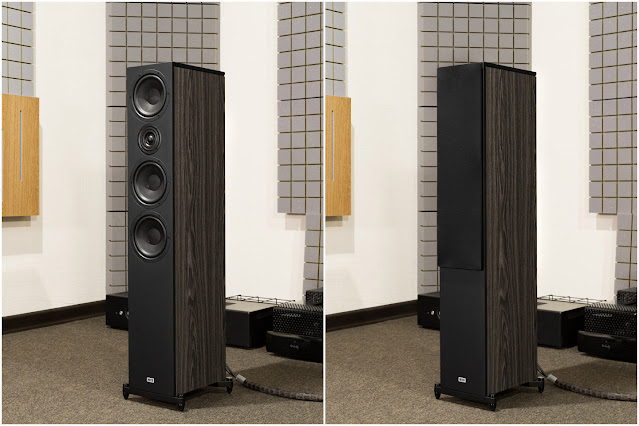 |
Acoustics with grill and without looks great. By the way, the white speakers have a nice gray grille. |
Looks great, I must say. The case when you have not listened to acoustics yet, but are already ready to buy. I liked the white version more, but the black one looks no less expensive and noble.
Revolutionary design
From an engineering point of view, Aurora is also very, very good. It combines reasonable savings in matters that do not fundamentally affect quality, and an “adult” approach to the implementation of key elements. For example, phase inverters, which look very similar to aluminum, are actually made of plastic. They have the correct aerodynamic shape and are securely fixed in the body with screws. The base of the floorstanders is made of plastic. Its construction is strong and light, with numerous stiffening ribs. And in appearance, the support is also very similar to expensive, but optional in this situation, aluminum. But they did not save on the legs themselves - beautiful large metal cones, it seems, were expropriated from some expensive acoustics.
 |
Diffuser and suspension are externally indistinguishable from those used in the older model Elementa |
The origin of the diffusers of the midrange and woofers is unequivocally identified - they were taken from the older Elementa line, but the baskets are “folk” - steel, stamped, without bourgeois excesses, like casting from expensive aluminum.
When creating the new Fluctus tweeter, the engineers used only proletarian ingenuity. The plastic flange was given a wave-like shape, like circles on the water, diverging from a fallen drop. It looks very fresh and avant-garde, but most importantly, it allows you to significantly even out the nature of the propagation of sound waves at different angles without any complex and expensive tricks such as horns or acoustic lenses. The tweeter's fabric dome is 28mm in diameter with a wide surround, and looks like it's also taken from the Elementa series.
Heavy artillery
The configuration of the Aurora model is three-way, the midrange is located at the top, and at the bottom there are two identical bass speakers. Both have a diameter of 170 mm and rubber surrounds that allow for a large stroke, which allows you to achieve significant sound pressure. Then I propose to delve into the numbers: the maximum acoustic power is 300 W, and the sensitivity is 92 dB. With the dimensions of the Aurora 700, this is difficult to compare, but listening experience suggests that even at very high volumes there is no noticeable compression or distortion increase. I didn't manage to piss off these speakers, but meanwhile the room was quite spacious, about 30-40 m². What is characteristic is that the acoustics are not lost even at low volumes, they sound full, without loss of details and lack of microdynamics.
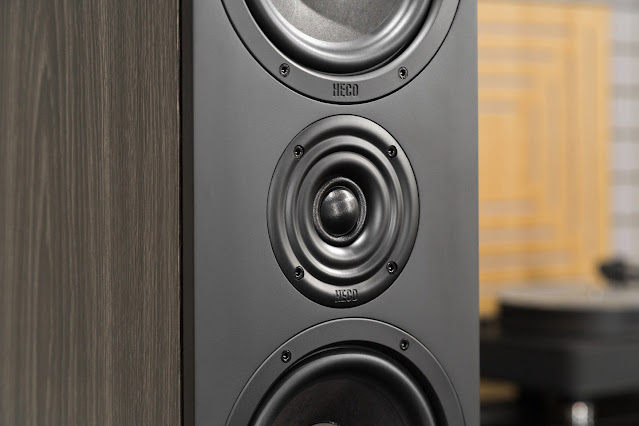 |
Wavy design of the tweeter allows you to control the dispersion of sound waves |
The sound as a whole corresponds to the Heco brand canons: clean, detailed, collected and at the same time not without warmth in the mid-frequency range. As always, classics are excellently reproduced, high-quality recordings of jazz and any other music with live instruments. Rock music sounded surprisingly well, and absolutely the whole spectrum, from the Beatles and classic hard-n-heavy to modern progressive trends. It was on this music that Aurora showed very good dynamic capabilities and rhythm, without which it is impossible to talk about the accuracy of reproduction of a good half of musical genres.
I really liked the nature of the reproduction of the bass range. The bass reflexes are set low, so the mid and upper bass are almost perfectly controlled, which makes the speakers play tight, as if using a closed acoustic design. The deepest notes are slightly less focused, but this is not heard too often and does not spoil the overall impression of the sound.
 |
Low-frequency cones have a fairly large working stroke |
If we compare the Aurora with the twice as expensive Elementa, I will notice that I liked the low-frequency character of the novelty even more. The Aurora bass is more versatile and, in my opinion, is better suited for energetic music like metal or aggressive electronics, while the Elementa at such moments began to sound deliberately strict and academic, not going all out with the music. If we compare the sound in general, then in terms of resolution and microdynamics, Aurora, without a doubt, loses to Elementa, but definitely not twice. In its budget, the novelty is more than good.
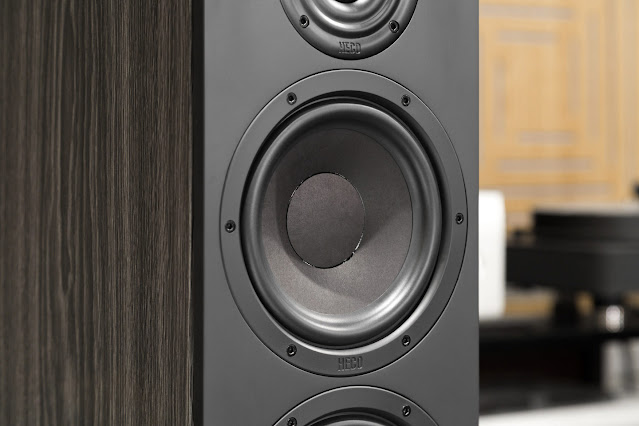 |
The dynamic performance of the Aurora 700 is surprisingly good. |
I found confirmation of this when listening to "Libertango". The clatter of the accordion buttons was clearly audible, although the price tag of the Aurora hints that we are not at the limit of perfection, and that a richer budget is needed for complete immersion in audiophilia. Is it really necessary? Big question. I can fully imagine the battle of the best speakers in this price group, and the number of participants can be counted on the fingers of one hand.
Revolutionary focus
The new Fluctus tweeter deserves special attention, or rather, the study of its behavior in real conditions. No matter how I twisted these speakers, at what angle I just listened! The result is quite interesting. The uppers are generally soft, giving a very accurate, slightly simplified hi-hat click and at the same time a completely natural metallic sound of an open free hit on a cymbal. In this they resemble vintage speakers in character, thus logically complementing the lively sound of the middle. Plays nice and conducive to long listening.
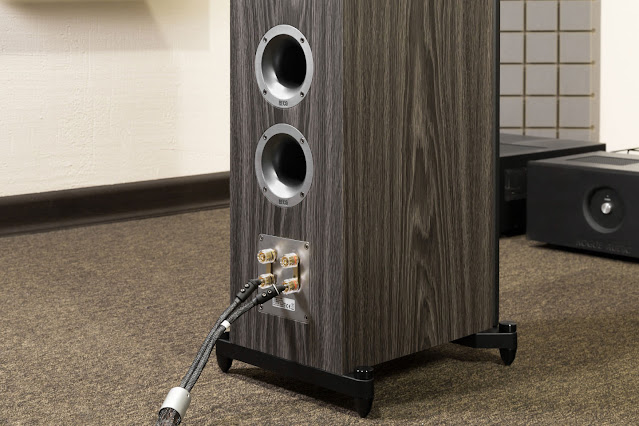 |
Two phase inverters are tuned low - it is extremely rare to hear their work |
It will not be possible to significantly strengthen the upper ones or make them sharper even sitting strictly on the radiation axis, but something else is curious here. With a deviation from the axis by 40-60 degrees in each direction, the character of the upper ones does not actually change in any way. I can’t say that the directivity is absolutely wide, but it is many times wider than what usually happens with tweeters with a flat flange or a shallow horn.
Choosing the installation position perfectly accurately, I would not direct the acoustics at the listener. There are no fundamental advantages in the quality of rendering a stereo image; even without precise focusing, the scene turns out to be worked out in all directions. But strictly on the axis, the sound is more tied to the speakers than in a situation where the radiation axis is directed somewhat to the side. The best option is when the acoustics are deployed a little wider: in this case, the sound is in no way associated with the location of the speakers in the room, and the feeling of a three-dimensional stage is not lost even with a significant shift away from the listening point.
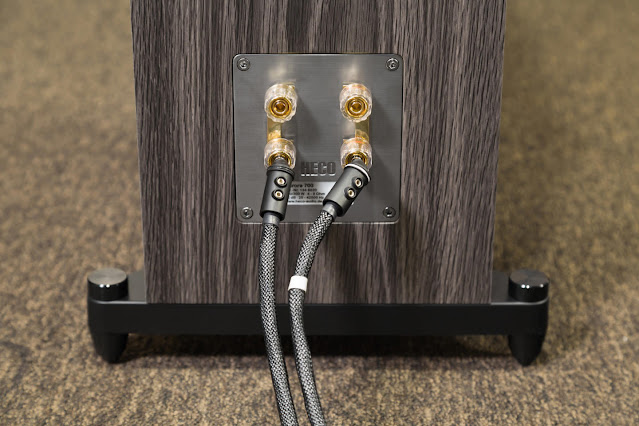 |
The quality of the fit is impeccable. Here, for example, the terminal pad is installed without a visible gap around the entire perimeter |
Going back to where it all began, I summarize: the tweeter flange really gives the desired effect. The sound dispersion is wide, the sound is comfortable. What else is needed?
conclusions
The Aurora 700 floorstanders look bold. Their revolutionary design will find both admirers and detractors. But this, in my opinion, is better than trying to please everyone at once. Sonically, the Aurora 700s are much more versatile and more likely to please everyone or almost everyone. The absence of pronounced coloration, good dynamic capabilities, high sensitivity, solid overload capacity, the ability to adequately build a sound picture at various volume levels - all this is not combined in one model as often as we would like.
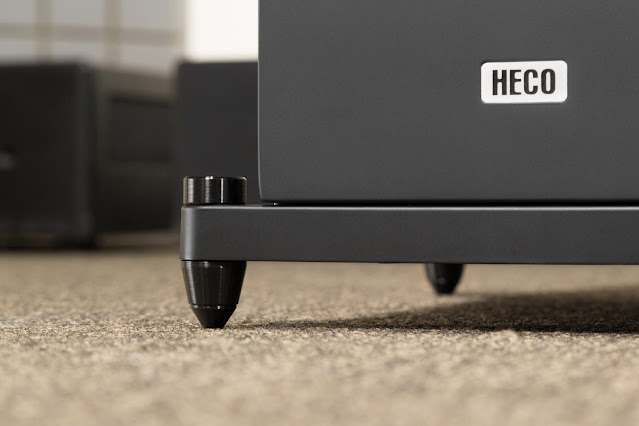 |
Solid support spikes on the paws extended to the side are not only beautiful, but also practical and convenient |
Separately, I would like to highlight the nature of the spread of high frequencies and the embedding of the scene as a whole. The speakers sound voluminous and realistic, regardless of the position of the listener in the room, while not blurring the sound picture. This property is relevant not only in stereo and background listening, but also in home theater. However, this will need to be checked separately.
High class sound quality, wide directivity, practical matte finish, comfortable adjustable feet.
The design and choice of finishes will not appeal to everyone.
Heco Aurora 700 specifications
Number of bands: 3
Tweeter: 28 mm, fabric dome
Midrange driver: 170 mm, kraft paper cone
Woofer: 2x170 mm, kraft paper cone
Frequency range: 25-42500Hz
Crossover frequency: 290 and 3300 Hz
Sensitivity: 92 dB
Recommended amplifier power: 30-300W
Impedance: 4-8 ohm
Dimensions: 195x1000x325 mm
Weight: 19.9 kg


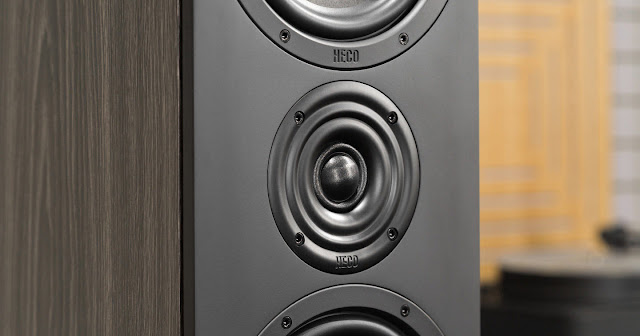










.jpg)



0 Comments